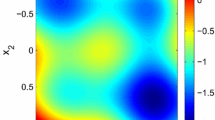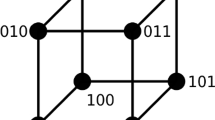Abstract
Submodular constraints play an important role both in theory and practice of valued constraint satisfaction problems (VCSPs). It has previously been shown, using results from the theory of combinatorial optimisation, that instances of VCSPs with submodular constraints can be minimised in polynomial time. However, the general algorithm is of order O(n 6) and hence rather impractical. In this paper, by using results from the theory of pseudo-Boolean optimisation, we identify several broad classes of submodular constraints over a Boolean domain which are expressible using binary submodular constraints, and hence can be minimised in cubic time. Furthermore, we describe how our results translate to certain optimisation problems arising in computer vision.
Similar content being viewed by others
References
Billionet, A., & Minoux, M. (1985). Maximizing a supermodular pseudo-Boolean function: A polynomial algorithm for cubic functions. Discrete Applied Mathematics, 12, 1–11.
Bistarelli, S., Fargier, H., Montanari, U., Rossi, F., Schiex, T., & Verfaillie, G. (1999). Semiring-based CSPs and valued CSPs: Frameworks, properties, and comparison. Constraints, 4, 199–240.
Boros, E., & Hammer, P. L. (2002). Pseudo-Boolean optimization. Discrete Applied Mathematics, 123(1–3), 155–225.
Bulatov, A. A., Krokhin, A. A., & Jeavons, P. (2005). Classifying the complexity of constraints using finite algebras. SIAM Journal on Computing, 34(3), 720–742.
Cohen, D., Cooper, M., & Jeavons, P. (2006). An algebraic characterisation of complexity for valued constraints. In Proceedings of the 12th international conference on principles and practice of contraint programming (CP). Lecture notes in computer science (Vol. 4204). New York: Springer.
Cohen, D., Cooper, M., & Jeavons, P. (2008). Generalising submodularity and Horn clauses: Tractable optimization problems defined by tournament pair multimorphisms. Theoretical Computer Science, 401, 36–51.
Cohen, D., Cooper, M., Jeavons, P., & Krokhin, A. (2005). Supermodular functions and the complexity of MAX-CSP. Discrete Applied Mathematics, 149, 53–72.
Cohen, D., Cooper, M., Jeavons, P., & Krokhin, A. (2006). The complexity of soft constraint satisfaction. Artificial Intelligence, 170, 983–1016.
Cooper, M. (2005). High-order consistency in valued constraint satisfaction. Constraints, 10, 283–305.
Cooper, M. C. (2008). Minimization of locally defined submodular functions by optimal soft arc consistency. Constraints, 13(4), 437–458.
Crama, Y. (1989). Recognition problems for special classes of polynomials in 0-1 variables. Mathematical Programming, 44, 139–155.
Creignou, N., Khanna, S., & Sudan, M. (2001). Complexity classification of boolean constraint satisfaction problems. In SIAM monographs on discrete mathematics and applications (Vol. 7). Philadelphia: SIAM.
Dechter, R. (2003). Constraint processing. San Francisco: Morgan Kaufmann.
Deineko, V., Jonsson, P., Klasson, M., & Krokhin, A. (2008). The approximability of Max CSP with fixed-value constraints. Journal of the ACM 55(4).
Feige, U., Mirrokni, V. S., & Vondrák, J. (2007). Maximizing non-monotone submodular functions. In Proceedings of the 48th annual IEEE symposium on foundations of computer science (FOCS’07). Los Alamitos: IEEE Computer Society.
Freedman, D., & Drineas, P. (2005). Energy minimization via graph cuts: Settling what is possible. In IEEE computer society conference on computer vision and pattern recognition (CVPR). Los Alamitos: IEEE Computer Society.
Gallo, G., & Simeone, B. (1988). On the supermodular knapsack problem. Mathematical Programming, 45, 295–309.
Geman, S., & Geman, D. (1984). Stochastic relaxation, Gibbs distributions, and the Bayesian restoration of images. IEEE Transactions on Pattern Analysis and Machine Intelligence, 6, 721–741.
Goldberg, A., & Tarjan, R. (1988). A new approach to the maximum flow problem. Journal of the ACM, 35, 921–940.
Gutin, G., Rafiey, A., Yeo, A., & Tso, M. (2006). Level of repair analysis and minimum cost homomorphisms of graphs. Discrete Applied Mathematics, 154, 881–889.
Hammer, P. L. (1965). Some network flow problems solved with pseudo-Boolean programming. Operations Research, 13, 388–399.
Iwata, S. (2008). Submodular function minimization. Mathematical Programming, 112, 45–64.
Iwata, S., & Orlin, J. B. (2009). A simple combinatorial algorithm for submodular function minimization. In Proceedings of the 20th annual ACM-SIAM symposium on discrete algorithms (SODA).
Jeavons, P., Cohen, D., & Cooper, M. (1998). Constraints, consistency and closure. Artificial Intelligence, 101(1–2), 251–265.
Jonsson, P., Klasson, M., & Krokhin, A. (2006). The approximability of three-valued MAX CSP. SIAM Journal on Computing, 35(6), 1329–1349.
Kohli, P., Kumar, M. P., & Torr, P. H. S. (2007). P3 & beyond: Solving energies with higher order cliques. In IEEE computer society conference on computer vision and pattern recognition (CVPR). Los Alamitos: IEEE Computer Society.
Kohli, P., Ladický, L., & Torr, P. (2009). Robust higher order potentials for enforcing label consistency. International Journal of Computer Vision, 82(3), 302–324.
Kolmogorov, V., & Zabih, R. (2004). What energy functions can be minimized via graph cuts? IEEE Transactions on Pattern Analysis and Machine Intelligence, 26(2), 147–159.
Lan, X., Roth, S., Huttenlocher, D. P., & Black, M. J. (2006). Efficient belief propagation with learned higher-order Markov random fields. In Proceedings of the 9th European conference on computer vision (ECCV), Part II. Lecture notes in computer science (Vol. 3952). Springer: Springer.
Lauritzen, S. L. (1996). Graphical models. Oxford: Oxford University Press.
Montanari, U. (1974). Networks of constraints: Fundamental properties and applications to picture processing. Information Sciences, 7, 95–132.
Nemhauser, G., & Wolsey, L. (1988). Integer and combinatorial optimization. New York: Wiley.
Orlin, J. B. (2009). A faster strongly polynomial time algorithm for submodular function minimization. Mathematical Programming, 118, 237–251.
Paget, R., & Longstaff, I. D. (1998). Texture synthesis via a noncausal nonparametric multiscale Markov random field. IEEE Transactions on Image Processing, 7(6), 925–931.
Ramalingam, S., Kohli, P., Alahari, K., & Torr, P. (2008). Exact inference in multi-label CRFs with higher order cliques. In IEEE computer society conference on computer vision and pattern recognition (CVPR). Los Alamitos: IEEE Computer Society.
Rhys, J. (1970). A selection problem of shared fixed costs and network flows. Management Science, 17(3), 200–207.
Rossi, F., van Beek, P., & Walsh, T. (Eds.) (2006). The handbook of constraint programming. Amsterdam: Elsevier.
Roth, S., & Black, M. J. (2005). Fields of experts: A framework for learning image priors. In IEEE computer society conference on computer vision and pattern recognition (CVPR). Los Alamitos: IEEE Computer Society.
Rother, C., Kohli, P., Feng, W., & Jia, J. (2009). Minimizing sparse higher order energy functions of discrete variables. In IEEE computer society conference on computer vision and pattern recognition (CVPR). Los Alamitos: IEEE Computer Society.
Schiex, T., Fargier, H., & Verfaillie, G. (1995). Valued constraint satisfaction problems: Hard and easy problems. In Proceedings of the 14th international joint conference on artificial intelligence (IJCAI).
Schrijver, A. (2000). A combinatorial algorithm minimizing submodular functions in strongly polynomial time. Journal of Combinatorial Theory, Series B, 80, 346–355.
Schrijver, A. (2003). Combinatorial optimization: Polyhedra and efficiency. In Algorithms and combinatorics (Vol. 24). New York: Springer.
Werner, T. (2007). A linear programming approach to Max-Sum problem: A review. IEEE Transactions on Pattern Analysis and Machine Intelligence, 29(7), 1165–1179.
Zalesky, B. (2003). Efficient determination of Gibbs estimators with submodular energy functions. arXiv:math/0304041v1, version February 2008.
Živný, S., Cohen, D. A., & Jeavons, P. G. (2009). The expressive power of binary submodular functions. Discrete Applied Mathematics, 157(15), 3347–3358.
Author information
Authors and Affiliations
Corresponding author
Additional information
A preliminary version of this paper appeared in Proceedings of the 14th International Conference on Principles and Practice of Constraint Programming (CP), 2008, pp. 112–127.
Rights and permissions
About this article
Cite this article
Živný, S., Jeavons, P.G. Classes of submodular constraints expressible by graph cuts. Constraints 15, 430–452 (2010). https://doi.org/10.1007/s10601-009-9078-z
Published:
Issue Date:
DOI: https://doi.org/10.1007/s10601-009-9078-z




